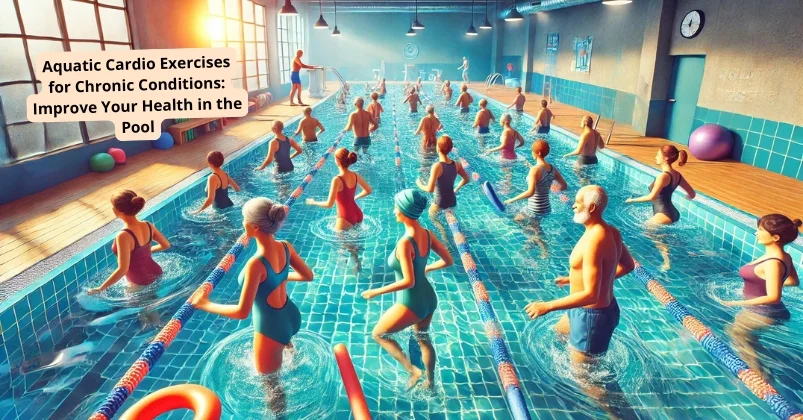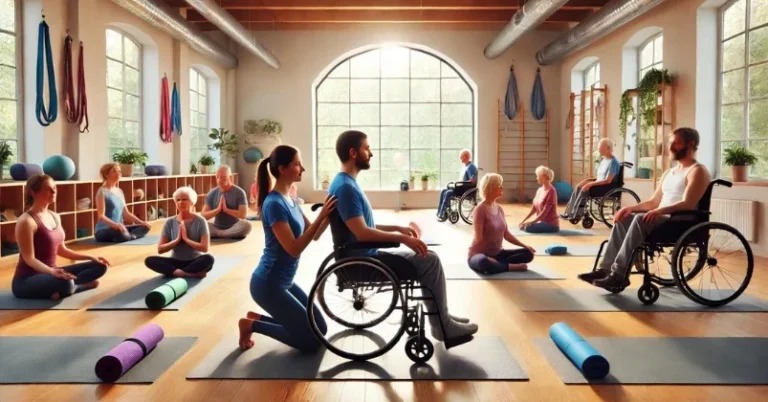Aquatic Cardio Exercises for Chronic Conditions: Improve Your Health in the Pool
Aquatic cardio exercises have been gaining popularity in recent years due to their low-impact nature and ability to improve cardiovascular health. This form of exercise involves performing various cardio exercises in water, which provides resistance and buoyancy that can help strengthen muscles and improve heart health.
In particular, aquatic cardio exercises are beneficial for individuals with chronic conditions such as arthritis, fibromyalgia, and multiple sclerosis. These conditions can often limit physical activity due to pain, joint stiffness, or muscle weakness. However, the buoyancy of water can help reduce the impact on joints and provide support for weak muscles, making it easier for individuals with chronic conditions to exercise.
Research has shown that aquatic cardio exercises can help improve cardiovascular fitness, muscular strength, and overall quality of life for individuals with chronic conditions. In this article, we will explore some of the best aquatic cardio exercises for chronic conditions and provide tips for getting started with this form of exercise.
Understanding Aquatic Cardio Exercises
Aquatic cardio exercises are a type of water-based exercise that can provide numerous benefits for people with chronic conditions. This type of exercise is an excellent way to improve cardiovascular fitness, build endurance, and burn calories while reducing the impact on joints.
What are Aquatic Cardio Exercises?
Aquatic cardio exercises are exercises performed in water that get your heart rate up and increase your breathing rate. They can include a range of activities such as water aerobics, swimming, aqua jogging, and more. These exercises use the resistance of the water to provide a full-body workout that is low-impact and easy on the joints.
Benefits of Aquatic Cardio Exercises
Aquatic cardio exercises provide many benefits for people with chronic conditions. These exercises can help improve cardiovascular fitness, build endurance, and burn calories. Additionally, they can help reduce the risk of injury by providing a low-impact workout that is gentle on the joints.
Who Can Benefit from Aquatic Cardio Exercises?
Aquatic cardio exercises are suitable for people of all ages and fitness levels, including those with chronic conditions. They are particularly beneficial for people with joint pain, arthritis, or other conditions that make high-impact exercises difficult. Additionally, they are an excellent option for people who are overweight or obese, as the buoyancy of the water can help reduce the stress on their joints.
How to Get Started with Aquatic Cardio Exercises
To get started with aquatic cardio exercises, you will need access to a pool. Many fitness centers, community centers, and YMCAs offer water-based exercise classes. Alternatively, you can perform these exercises on your own by swimming laps or doing water aerobics. It is important to start slowly and gradually increase your intensity and duration as your fitness level improves.
Overall, aquatic cardio exercises are an excellent way to improve cardiovascular fitness, build endurance, and burn calories while reducing the impact on joints. They are suitable for people of all ages and fitness levels and can provide numerous benefits for people with chronic conditions.
Benefits of Aquatic Cardio Exercises
Aquatic cardio exercises offer a wide range of benefits for individuals with chronic conditions. Here are some of the key benefits of aquatic cardio exercises:
Low-Impact Exercise
Aquatic cardio exercises are low-impact, which means they are easy on the joints and muscles. The buoyancy of water reduces stress on the body, making it an ideal exercise for individuals with chronic conditions such as arthritis, fibromyalgia, or osteoporosis.
Cardiovascular Health
Aquatic cardio exercises can improve cardiovascular health by increasing the heart rate and improving circulation. This can help reduce the risk of heart disease, stroke, and other cardiovascular conditions.
Resistance Training
Water provides natural resistance, which can help build muscle and improve strength. This makes aquatic cardio exercises an effective form of resistance training.
Range of Motion
The buoyancy of water allows for a greater range of motion, making it easier to perform exercises that may be difficult on land. This can help improve flexibility and range of motion.
Mental Health
Aquatic cardio exercises can also have positive effects on mental health. Regular exercise has been shown to improve mood, reduce stress and anxiety, and improve sleep quality.
Cross-Training and Weight-Bearing Exercises
Aquatic cardio exercises can be used as a form of cross-training, complementing other forms of exercise such as weight-bearing exercises. This can help improve overall physical fitness and bone health.
Quality of Life
Regular exercise has been shown to improve the quality of life for individuals with chronic conditions. Aquatic cardio exercises offer a safe and effective form of exercise that can help improve overall health and well-being.
In summary, aquatic cardio exercises offer a low-impact, versatile, and effective form of exercise for individuals with chronic conditions. They can improve cardiovascular health, build muscle and strength, increase flexibility and range of motion, and have positive effects on mental health and quality of life.
Aquatic Cardio Exercises for Chronic Conditions
Aquatic cardio exercises can be an effective way to manage chronic conditions such as arthritis, diabetes, heart disease, fibromyalgia, rheumatoid arthritis, and osteoarthritis. These exercises are low-impact and can help reduce joint pain and inflammation, making them a great option for those with chronic pain.
One of the main benefits of aquatic cardio exercises is the buoyancy of the water, which reduces the impact on joints and allows for a more comfortable workout. This can be especially beneficial for those with back pain or joint pain, as it reduces the stress in these areas.
Water-based exercises can also help improve cardiovascular health, which is important for those with chronic conditions such as heart disease and diabetes. The resistance provided by the water can help build strength and endurance, which can lead to improved overall health.
When compared to land-based exercise, aquatic cardio exercises are more effective in reducing pain levels and improving mobility in those with chronic conditions. Additionally, water-based exercise can be a more enjoyable option for those who may find land-based exercise too challenging or uncomfortable.
Some examples of aquatic cardio exercises for chronic conditions include:
- Water aerobics
- Swimming laps
- Water jogging or running
- Aqua cycling
- Water kickboxing
It is important to consult with a healthcare professional before beginning any new exercise program, especially if you have a chronic condition. They can help you determine which exercises are safe and appropriate for your individual needs and abilities.
In summary, aquatic cardio exercises can be a safe and effective way to manage chronic conditions such as arthritis, diabetes, heart disease, and more. These low-impact exercises can reduce joint pain and inflammation, improve cardiovascular health, and be a more enjoyable option for those who may struggle with land-based exercise.
Aquatic Cardio Exercises for Older Adults
Aquatic cardio exercises can be a great way for older adults to improve their cardiovascular fitness without putting excessive stress on their joints. According to the Physical Activity Guidelines for Americans, older adults should aim for at least 150 minutes of moderate-intensity aerobic activity per week. Swimming, water aerobics, and other aquatic exercises can be a fun and effective way for older adults to meet this goal.
One of the benefits of aquatic exercise is that it can reduce the fear of falling that some older adults may experience during land-based exercise. The buoyancy of the water can make movements feel easier and less intimidating, which can help build confidence and reduce the risk of injury.
Water aerobics classes are a popular option for older adults who want to improve their cardiovascular fitness in a supportive and social environment. These classes typically involve a series of exercises that are performed in shallow water, such as jogging, jumping jacks, and arm movements. The resistance of the water provides an added challenge that can help improve muscular strength and endurance.
Swimming is another great option for older adults who want to improve their cardiovascular fitness. Swimming can be a low-impact exercise that is easy on the joints, making it a great option for people with arthritis or other chronic conditions. Additionally, swimming can burn a significant number of calories, making it an effective way to maintain a healthy weight.
Overall, aquatic cardio exercises can be a safe and effective way for older adults to improve their cardiovascular fitness and reduce the risk of chronic conditions. By incorporating aquatic exercise into their fitness routine, older adults can improve their overall health and well-being.
Influence of Water Temperature on Exercise
Water temperature can have a significant impact on aquatic exercise, including its influence on fatigue and cardiovascular responses during exhaustive aquatic exercise. According to a study published in the Journal of Sports Sciences, a water temperature of 31 °C, which is generally perceived to be thermoneutral in the water, can lead to cardiovascular strain and a reduction in performance during exercise.
Warm water is often recommended for aquatic exercise as it can help to relax muscles, reduce pain, and increase flexibility. It can also improve blood flow, which can help to reduce swelling and inflammation. The ideal water temperature for aquatic exercise can vary depending on the individual's needs and preferences, but a temperature of around 83-88°F (28-31°C) is generally considered to be comfortable and effective for most people.
It is important to note that the water temperature can also affect the effectiveness of aquatic exercise for weight loss and body composition. A study published in the Journal of Physical Therapy Science found that immersion in warm water (35°C) before exercise can increase the body's metabolic rate and lead to greater fat loss compared to immersion in cold water (25°C). However, other studies have shown that cold water immersion can also have benefits, such as reducing inflammation and improving recovery after exercise.
Overall, the ideal water temperature for aquatic exercise can vary depending on the individual's needs and goals. Warm water is generally recommended for relaxation and pain relief, while cooler water can be beneficial for recovery and reducing inflammation. It is important to consult with a healthcare professional or certified aquatic exercise specialist to determine the best water temperature and exercise program for your specific needs and condition.
Equipment for Aquatic Cardio Exercises
When it comes to aquatic cardio exercises, the right equipment can make all the difference. Here are some of the essential pieces of equipment you'll need to get started:
Flotation Devices
Flotation devices can be a great tool for those who are just starting with aquatic cardio exercises or those who need additional support. They can help you stay afloat and provide resistance to your movements. Some popular flotation devices include:
- Kickboards: These are great for working your lower body and can be used for exercises like leg lifts and flutter kicks.
- Noodles: Noodles are a versatile tool that can be used for a variety of exercises, including arm curls, leg lifts, and balance exercises.
- Aqua jogger belts: These belts are designed to keep you upright and provide support for your lower back. They're great for deep-water exercises like jogging and running.
Resistance Equipment
Resistance equipment can help you build strength and endurance during your aquatic cardio workouts. Some popular resistance equipment includes:
- Aqua dumbbells: These are similar to regular dumbbells but are made of foam or plastic to make them buoyant. They're great for exercises like bicep curls and shoulder presses.
- Resistance bands: These can be used to add resistance to your movements and can be anchored to the side of the pool or held by a partner.
- Paddle gloves: These gloves are designed to increase resistance during arm movements and can be used for exercises like swimming and water aerobics.
Other Equipment
In addition to flotation and resistance equipment, there are a few other pieces of equipment that can be helpful during aquatic cardio exercises:
- Water shoes: These can provide traction on the pool floor and protect your feet from rough surfaces.
- Waterproof heart rate monitor: This can help you track your heart rate during your workout and ensure you're staying within your target heart rate zone.
- Waterproof music player: Listening to music can help you stay motivated during your workout, and a waterproof music player will allow you to enjoy your favorite tunes while in the pool.
Overall, the right equipment can make aquatic cardio exercises more enjoyable and effective. Whether you're a beginner or an experienced swimmer, there's a piece of equipment that can help you get the most out of your workout.
Aquatic Cardio Exercise Techniques
Aquatic exercises provide a low-impact workout that can be beneficial for individuals with chronic conditions. Here are some techniques for aquatic cardio exercises that can help improve cardiovascular health:
Walking
Walking in water is a low-impact exercise that can be done in shallow or deep water. It can help improve balance, increase endurance, and strengthen muscles. To perform this exercise, walk forward, backward, or side to side in the water, keeping your core engaged and arms moving.
Swimming
Swimming is a great way to get a full-body workout. It can help improve cardiovascular health, increase muscle strength, and reduce stress. To perform this exercise, swim laps or use different strokes to work different muscle groups.
Running
Running in water is a low-impact exercise that can be done in deep water with the help of a flotation device. It can help improve cardiovascular health, increase endurance, and strengthen muscles. To perform this exercise, run in place or move forward, backward, or side to side in the water.
Knees to Chest
Knees to the chest is an exercise that can help improve core strength, flexibility, and balance. To perform this exercise, stand in chest-deep water and bring one knee up to your chest while keeping the other leg straight. Alternate legs and repeat.
Jumping Jacks
Jumping jacks in water are a low-impact exercise that can help improve cardiovascular health, increase endurance, and strengthen muscles. To perform this exercise, stand in chest-deep water and jump while spreading your legs and arms apart. Jump back to the starting position and repeat.
Side Shuffle
Side shuffling in water is a low-impact exercise that can help improve cardiovascular health, increase endurance, and strengthen muscles. To perform this exercise, stand in chest-deep water and take quick steps to the side while keeping your feet and knees together. Repeat in the opposite direction.
Overall, aquatic cardio exercises can be a great way to improve cardiovascular health while being gentle on the joints. It is important to consult with a healthcare professional before starting any exercise program, especially if you have a chronic condition.
Role of Aquatic Cardio Exercises in Physical Therapy
Aquatic cardio exercises have been used extensively in physical therapy to help patients with chronic conditions. Hydrotherapy, which is the use of water for therapeutic purposes, is effective in reducing pain and improving physical function in individuals with chronic conditions such as osteoarthritis, fibromyalgia, and chronic lower back pain.
Aquatic cardio exercises are particularly useful in physical therapy because they provide a low-impact workout that is easy on the joints and muscles. The buoyancy of water reduces the amount of weight placed on the joints, which can decrease pain and inflammation. Additionally, the resistance of the water provides a challenging workout that can improve cardiovascular fitness, muscular strength, and endurance.
Physical therapists often use aquatic cardio exercises as part of a comprehensive treatment plan for chronic conditions. These exercises can be tailored to the individual needs of the patient, making them an effective and safe option for people of all ages and fitness levels.
Studies have shown that aquatic cardio exercises can be effective in reducing pain and improving physical function in individuals with chronic conditions. For example, a study published in the Journal of Aging and Physical Activity found that aquatic exercise was effective in reducing pain and improving physical function in older adults with osteoarthritis.
In conclusion, aquatic cardio exercises play an important role in physical therapy for individuals with chronic conditions. They provide a low-impact workout that is easy on the joints and muscles, while also improving cardiovascular fitness, muscular strength, and endurance. Hydrotherapy is effective in reducing pain and improving physical function in individuals with chronic conditions, making aquatic cardio exercises a safe and effective option for physical therapy.
Aquatic Cardio Exercises for Specific Health Conditions
Aquatic cardio exercises have been shown to have numerous health benefits for individuals with chronic conditions. Here are some examples of how aquatic cardio exercises can benefit specific health conditions:
Type 2 Diabetes
According to a systematic review analysis, water-based training (WT) programs can improve glycemic control and insulin sensitivity in individuals with type 2 diabetes. Aquatic exercises can also help reduce the risk of cardiovascular disease, which is a common complication of diabetes. Examples of aquatic cardio exercises for individuals with type 2 diabetes include water walking, water jogging, and swimming.
Coronary Artery Disease
Aquatic cardio exercises can be a safe and effective way for individuals with coronary artery disease to improve their cardiovascular health. A study published in the Journal of Cardiopulmonary Rehabilitation and Prevention found that aquatic exercises can improve exercise capacity, reduce blood pressure, and improve lipid profiles in individuals with coronary artery disease. Examples of aquatic cardio exercises for individuals with coronary artery disease include water aerobics, deep-water running, and swimming.
Hypertension
Aquatic cardio exercises can be a beneficial way to manage hypertension. According to a study published in the American Journal of Cardiology, aquatic exercises can help lower blood pressure in individuals with hypertension. Examples of aquatic cardio exercises for individuals with hypertension include water walking, water aerobics, and swimming.
Stroke
Aquatic cardio exercises can be a valuable form of rehabilitation for individuals who have suffered a stroke. A study published in the Journal of Neurologic Physical Therapy found that aquatic exercises can improve balance, gait, and functional mobility in individuals who have had a stroke. Examples of aquatic cardio exercises for individuals who have had a stroke include water walking, water aerobics, and swimming.
Multiple Sclerosis
Aquatic cardio exercises can be a safe and effective way for individuals with multiple sclerosis to improve their cardiovascular health. A study published in the International Journal of MS Care found that aquatic exercises can improve cardiovascular fitness, muscular strength, and mobility in individuals with multiple sclerosis. Examples of aquatic cardio exercises for individuals with multiple sclerosis include water aerobics, deep-water running, and swimming.
Overall, aquatic cardio exercises can be a safe and effective way for individuals with chronic conditions to improve their cardiovascular health. By working with a qualified aquatic exercise instructor, individuals can develop a customized aquatic exercise program that meets their specific health needs.
Recommendations from Health Institutions
Various health institutions have provided recommendations for aquatic cardio exercises for individuals with chronic conditions. The American College of Sports Medicine recommends that individuals with chronic conditions engage in at least 150 minutes per week of moderate-intensity aerobic activity, such as swimming or water aerobics, or 75 minutes per week of vigorous aerobic activity, or a combination of both, preferably spread throughout the week. Additionally, they recommend adding moderate- to high-intensity muscle-strengthening activity, such as resistance or weights, at least 2 days per week.
The Mayo Clinic recommends aquatic exercises for individuals with chronic conditions, such as arthritis, as it is a low-impact form of exercise that can help improve flexibility, strength, and balance. They suggest that individuals with arthritis or other chronic conditions start with simple exercises, such as walking in water or leg lifts, and gradually increase the intensity and duration of their workouts.
Furthermore, the National Institute on Aging states that almost anyone, at any age, can do some type of physical activity, even if they have a health condition like heart disease, arthritis, chronic pain, high blood pressure, or diabetes. Physical activity may help improve overall health and reduce the risk of chronic diseases.
In summary, health institutions recommend aquatic cardio exercises, such as swimming or water aerobics, for individuals with chronic conditions. It is important to start with simple exercises and gradually increase the intensity and duration of workouts. Adding moderate- to high-intensity muscle-strengthening activity is also recommended.
Staying Motivated for Regular Aquatic Cardio Exercises
Staying motivated to exercise can be challenging, especially for individuals with chronic conditions. However, regular exercise is essential for maintaining overall health and managing chronic conditions. Aquatic cardio exercises can be a great option for individuals with chronic conditions as they are low-impact and easy on the joints.
Here are some tips to help you stay motivated for regular aquatic cardio exercises:
1. Set Realistic Goals
Setting realistic goals is essential to staying motivated. It is important to set goals that are achievable and specific. For example, instead of setting a goal to exercise for an hour every day, start with a goal to exercise for 10-15 minutes, three times a week. As you progress, you can increase the duration and frequency of your exercise.
2. Find an Exercise Buddy
Exercising with a friend or family member can be a great way to stay motivated. Having someone to exercise with can make the experience more enjoyable and less intimidating. It can also provide accountability and support.
3. Mix Up Your Routine
Doing the same exercise routine every day can become boring and monotonous. Mix up your routine by trying different aquatic cardio exercises. This can help keep things interesting and challenging.
4. Reward Yourself
Rewarding yourself after achieving a goal can be a great way to stay motivated. This can be something as simple as treating yourself to a healthy snack or taking a relaxing bath after a workout. Rewards can help you stay focused and motivated.
5. Track Your Progress
Tracking your progress can help you stay motivated and see how far you have come. Keep a journal or use a fitness tracker to record your exercise routine, duration, and frequency. This can help you identify areas where you need to improve and celebrate your successes.
In conclusion, staying motivated for regular aquatic cardio exercises is essential for individuals with chronic conditions. Setting realistic goals, finding an exercise buddy, mixing up your routine, rewarding yourself, and tracking your progress can all help you stay motivated and achieve your fitness goals.
Conclusion
Aquatic cardio exercises can be a great option for individuals with chronic conditions who want to improve their cardiovascular fitness. Research has shown that aquatic exercise offers better advantages than land-based exercise for patients' balance, motor function, cardiorespiratory fitness, and functional independence.
Regular physical activity is a recognized cost-effective intervention for public health and is associated with an ever-widening constellation of health, economic, and other benefits, playing an important role in the prevention and management of many major chronic conditions.
Aquatic exercises have also become a major element in rehabilitation programs for several diseases, for physical conditions, and to enhance sports performance in athletes. The water environment has advantageous physical properties for exercise, and it is an alternative tool to perform resistance training.
In conclusion, aquatic cardio exercises can be a safe and effective way for individuals with chronic conditions to improve their cardiovascular fitness. However, it is important to consult with a healthcare provider before starting any exercise program and to work with a qualified aquatic exercise instructor to ensure proper technique and safety.
FAQs
Aquatic exercises provide a low-impact workout that is gentle on the joints, making it an ideal form of exercise for individuals with chronic conditions. The natural resistance of water also helps to strengthen muscles and improve cardiovascular health. Additionally, aquatic exercises can help to reduce stress and improve overall muscular endurance and strength.
Yes, aquatic exercises can be an effective way to improve knee strength. The buoyancy of water helps to reduce the impact on the joints, making it easier to perform exercises that may be too difficult on land. Some recommended knee-strengthening exercises include water walking, water squats, and leg lifts.
Many different aquatic exercises can be beneficial for individuals with chronic illnesses. Some recommended exercises include water walking, water aerobics, water cycling, and swimming. These exercises can help to improve cardiovascular health, strengthen muscles, and reduce stress.
Aquatic exercises are generally considered to be a low-impact form of cardiovascular exercise. This makes them an ideal choice for individuals who may have difficulty with other forms of exercise, such as running or high-impact aerobics. Additionally, the natural resistance of water can help to increase muscle strength and endurance.
While aquatic fitness can be beneficial for many individuals, some medical conditions may make it unsafe. Individuals with open wounds, skin infections, or incontinence should avoid aquatic fitness. Additionally, individuals with heart conditions or respiratory problems should consult with their healthcare provider before beginning an aquatic exercise program.
Many different aquatic exercises can be beneficial for hips and thighs. Some recommended exercises include water walking, water squats, water lunges, and leg lifts. These exercises can help to strengthen the muscles in the hips and thighs, improve balance, and reduce the risk of falls.








